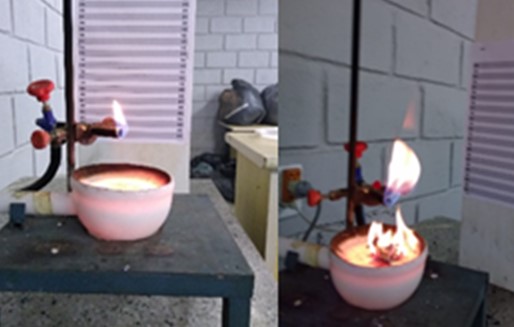Flammability evaluation of six native species in the southern region of Tocantins
DOI:
https://doi.org/10.20873/jbb.uft.cemaf.v7n4.ramosKeywords:
fire, flammable, CerradoAbstract
The woody vegetation of the Cerrado presents adaptive properties to the fire. The fires during the dry season may cause significant changes in the structure and floristic composition of the vegetation. This study aimed to evaluate the flammability of six native species of a Cerrado fragment located in southern Tocantins. Samples composed of fine materials of the selected species were collected, with a diameter of less than 7 mm, excluding young leaves and apical buds. For each species, 50 repetitions were performed, being analyzed: ignition frequency, ignition time, combustion duration, combustion index, and the determination of flammability value. Among the evaluated species, Curatella americana L., Clethra scabra Pers. and Anacardium occidentale L. Obtained significant values with emphasis on Clethra scabra Pers. Which obtained the highest mean values of the flammability variables. We also observed that most species had a combustion index classified as very high (CI = 4 and CI = 5). With this study we can conclude that most species are flammable, and Clethra scabra Pers. Was the species that presented the best result of the flammability variables being classified as highly flammable. On the other hand, Macrolobium limbatum Spruce ex Benth. var. limbatum and Ziziphus Cinnamomum Triana & Planch. Were the species that obtained the lowest results being classified as weakly flammable.
References
ANDERSON, H.E. (1970). Forest fuel ignitibility. Fire Tech-nology 6, p.312-322.
BARTON, C.M.; ULLAH, I.I.; BERGIN, S. Land use, water and Mediterranean landscapes: modelling long-term dynam-ics of complex socio-ecological systems. Philosophical Transactions da Royal Society, v.368, p.5275-5297, 2010.
COUTINHO, L.M.O Cerrado e a ecologia do fogo. Ciência Hoje, v.12, n.68, p.22-30, 1990b.
COUTINHO, L.M. Fire in the ecology of Brasilian Cerrado. In GOLDAMMER, J.G., (Ed.) Fire in the Tropical Biota: ecological processes and global challenges. Ecological Stu-dies. Berlin: Springer-Verlang, 1990. p.82-105.
EITEN, G. Vegetação do cerrado. In: PINTO, M.N. (Org). Cerrado: caracterização, ocupação e perspectivas. Brasília: Edunb/SEMATEC, 1994. p.17-73.
HERNANDO, C.L. Combustibles forestales: inflamabilidad. In: Vélez, R. M. (Coord). La defensa contra incêndios fores-tales: fundamentos y experiências, 2. ed. Espanha: Mcgrawhill, 2009.
KLINK, C.A. MACHADO, R.B.A conservação do Cerrado brasileiro. Megadiversidade. v.1, n.1. Julho 2005.
MARTIN, R.E.; GORDON, D.A.; GUTIERREZ, M.E; LEE, D.S; MOLINA, D.M.; SCHROEDER, R.A.; SAPSISDB STEPHENS, S.L.; CHAMBERSM. (1994). Assessing the flammability of domestic and wildland vegetation. In ‘Pro-ceedings of the 12th 60 conference on fire and forest mete-orology’, (Society of American Foresters: Bethesda, MD), Jekyll Island, GA. p. 130–137
NEVES, P.C. Avaliação da inflamabilidade de cinco espécies da floresta ombrófila mista. 2016.
PETRICCIONE, M. Infiammabilità della lettiera di diverse specie vegetali di ambiente mediterraneo. 2007. Tese de Doutorado. Università degli Studi di Napoli Federico II.
SOARES, R.V.; BATISTA, A.C.; Tetto, A.F. Incêndios florestais: controle, efeitos e uso do fogo. 2. ed. Curitiba, 2017. 255p.
PIVELLO, V.R.; COUTUNHO, L.M. The use of fire in the cerrado and amazonian rainforests of brazil: past and pre-sent. Fire ecology, 2011. v.7, n.1, p.24-39.
RIBEIRO, J.F.; WALTER, B.M.T. Fitofisionomias do bioma cerrado. In: SANO, S. M.; ALM EIDA, S. P. (Eds.). Cer-rado: ambiente e flora. Planaltina: Embrapa Cerrados, 1998. p.89-166.
RODRIGUEZ, Y.C. et al. Inflamabilidad de especies vegetales del ecosistema de pinares. Revista Cubana de Ciencias Fo-restales: CFORES, v.4, n.1, p.5, 2016.
VALETTE, J.C. Inflammabilities of mediterranean species. Porto Carras: Research and Development of the European Commission European School of Climatology and Natural Hazards, 1992. 12 p. (Document PIF9208).

Published
How to Cite
Issue
Section
License
Copyright (c) 2024 - Journal of Biotechnology and Biodiversity

This work is licensed under a Creative Commons Attribution 4.0 International License.
Authors who publish with this journal agree to the following terms:
Authors retain copyright and grant the journal right of first publication with the work simultaneously licensed under a Creative Commons Attribution License (CC BY 4.0 at http://creativecommons.org/licenses/by/4.0/) that allows others to share the work with an acknowledgement of the work's authorship and initial publication in this journal.
Authors are able to enter into separate, additional contractual arrangements for the non-exclusive distribution of the journal's published version of the work (e.g., post it to an institutional repository or publish it in a book), with an acknowledgement of its initial publication in this journal.
Authors are permitted and encouraged to post their work online (e.g. in institutional repositories or on their website) prior to and during the submission process, as it can lead to productive exchanges, as well as earlier and greater citation of published work (Available at The Effect of Open Access, at http://opcit.eprints.org/oacitation-biblio.html).


